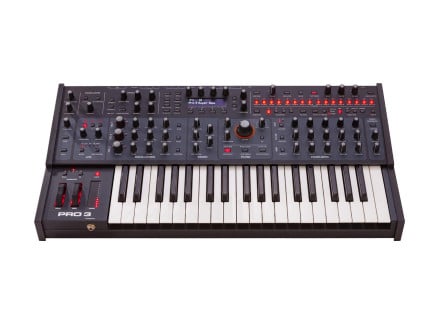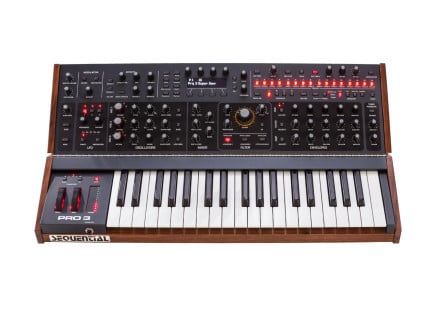Sequential's Gerry Bassermann visited our shop to demonstrate one of the most exciting announcements from NAMM 2020: the Pro 3, a new hybrid monosynth from Dave Smith and his team. Following in the lineage of the Pro-One and Pro-2, the Pro 3 challenges the concept of what a monosynth can be like—covering a staggering amount of ground from traditional leads and basslines to edgy digital textures, sequenced patterns, chords, and more.
Like the Pro-One and Pro-2 before it, the Pro 3 is a markedly unique synthesizer that turns seemingly humble internal resources into powerful tools for sculpting rich, complex timbres. Each of Sequential's "Pro" model synthesizers are, strictly speaking, monosynths—but they include such flexible and abundant opportunities for modulation that they often are capable of creating sound much more rich and nuanced than the average monophonic instrument.
The Pro 3's Voice
The Pro 3's voice architecture allows for the creation of tons of styles of synth sounds. It features three oscillators: two traditional VCOs and one wavetable oscillator. The VCOs allow for continuous alteration of waveshape from triangle through saw and into variable pulse waves. The wavetable oscillator offers access to a wide variety of sounds, from simple clean sines and analog-style shapes to drum sounds, vocal timbres, and abrasive digital tones.
The Pro 3's filter section includes three distinct options for analog filtering. The first filter type is a 4-pole OTA-based lowpass similar to the filter found in the Prophet-6. The second is a Moog-style 4-pole ladder filter, providing a distinct sonic flavor (with optional bass compensation at higher resonance settings). The final type is a 2-Pole state-variable designed based on the filter section in the OB-6, providing a considerably gentler, yet still colorful response. The Oberheim-style filter provides optional bandpass response, as well as a continuously morphable filter type that transforms from lowpass through notch and into highpass response. Between these three filter types, the Pro 3 can create a lot of different types of sounds.
The audio signal path terminates with a VCA and dual digital effect section, which contains a wide selection of time-based effects ranging from delays and reverbs to rotary and modulation effects (think chorus, flanger, etc.). These add a considerable amount of depth to the sound, and carefully choosing effect settings can dramatically alter the character of a timbre.
Playing the Pro 3
Of course, the hallmark of the Pro-series synthesizers is the immense potential for modulation: and in this sense, the Pro 3 truly delivers. It features looping envelopes, LFOs, a 16-track modulation sequencer, enormous modulation matrix, CV I/O, and plenty of performance controls. These combined with the integrated arpeggiator, velocity and aftertouch-capable keybed, and optional paraphonic operation make it possible to play the Pro 3 in any number of styles.
And that concept is perhaps the Pro 3's greatest strength: it has a natural ability to integrate into any workflow and produce nearly any type of sound. Whether you're a well-practiced keyboardist, a modular synth enthusiast, a beatmaker, a sound designer, or perhaps any other type of synthesist altogether, the Pro 3 has a workflow that should be able to easily adapt to your needs and programming/playing style. Use keys, use the sequencer, use the CV I/O, or just let it drone: you'll find an endless number of new timbres worth exploring.
We'll soon take a deeper dive into the Pro 3 and its similarities/dissimilarities to its ancestors—but for now, enjoy hearing more about its raw components and potential. More to come soon!









